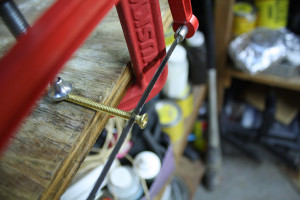
 Highland bagpiping requires a lot of skill, and not just the fingering kind. The demands on sound and bagpipe quality mean that Highland pipers need to be versed in a variety of techniques to sound their best. Mainly, the modern self-sufficient piper needs to be skilled in manipulating their own chanter reeds to get the awesome sound required for today’s competition boards. An active piper will certainly have the “tools of the trade” for reedsmithing: a sharp blade for scraping, hemp, a mandrel for poking, and other oddments necessary for instant use. Trouble is, these are usually in a box or pouch in one’s pipe case. Not much good when these things are needed out on the games pitch or in the band circle during tune-up. In the true Pipehacker tradition, here is a sporran-sized, exquisitely portable survival kit based on the Pipehacker Personal Reed Case and pipe-hacked, miniaturized versions of the tools you need for reed-hacking while practicing or fine tuning before performance time.
Highland bagpiping requires a lot of skill, and not just the fingering kind. The demands on sound and bagpipe quality mean that Highland pipers need to be versed in a variety of techniques to sound their best. Mainly, the modern self-sufficient piper needs to be skilled in manipulating their own chanter reeds to get the awesome sound required for today’s competition boards. An active piper will certainly have the “tools of the trade” for reedsmithing: a sharp blade for scraping, hemp, a mandrel for poking, and other oddments necessary for instant use. Trouble is, these are usually in a box or pouch in one’s pipe case. Not much good when these things are needed out on the games pitch or in the band circle during tune-up. In the true Pipehacker tradition, here is a sporran-sized, exquisitely portable survival kit based on the Pipehacker Personal Reed Case and pipe-hacked, miniaturized versions of the tools you need for reed-hacking while practicing or fine tuning before performance time.
 1. Make your mini mandrel. Cut the head off of the 10-24 bolt with the hacksaw (or, since you have Dremel tool, you will likely have a cutting wheel bit, which works perfectly). Unscrew the top bushing on the Xacto handle and remove the bushing and the blade chuck. Take the handle and screw in the bolt until tight. WEAR SAFETY GOGGLES and carefully use the grinding or emery bit on the Dremel to grind off the exposed threads on the remaining 2-1/16-inch length. Read More
1. Make your mini mandrel. Cut the head off of the 10-24 bolt with the hacksaw (or, since you have Dremel tool, you will likely have a cutting wheel bit, which works perfectly). Unscrew the top bushing on the Xacto handle and remove the bushing and the blade chuck. Take the handle and screw in the bolt until tight. WEAR SAFETY GOGGLES and carefully use the grinding or emery bit on the Dremel to grind off the exposed threads on the remaining 2-1/16-inch length. Read More